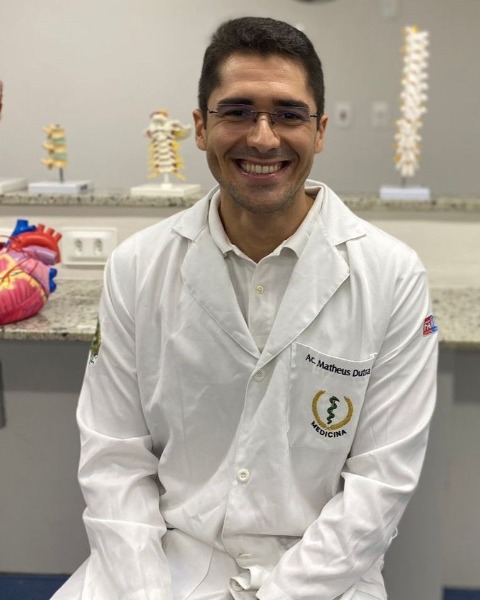Cardiovascular Posters
Poster: Cardiovascular Posters
22 - Aberrant Right Subclavian Artery : Case report
Sunday, March 24, 2024
5:00pm - 7:00pm US EDT
Location: Sheraton Hall
Poster Board Number: 22
There are separate poster presentation times for odd and even posters.
Odd poster #s – first hour
Even poster #s – second hour
Co-authors:
There are separate poster presentation times for odd and even posters.
Odd poster #s – first hour
Even poster #s – second hour
Co-authors:
Carlos Eduardo de Carvalho - Universidade do Estado do Amazonas; Isabela Cabral - UNL; Lauro coelho - UNL; Kaynanda da Silva - UNL; Yuri de Siqueira - UNL; Francisco Gomes Segundo - UNL; Layza Moreira - UNL; Vanessa Russo - UNL; Alice Souza - UEA; Heynner Barbosa - UEA; João Marcos Cavalcante - UEA; Mariana Yasmin Cavalcante - UEA; Samilla da Fonseca - UEA; Carlos da Silva - UEA; Pedro Dangelo da Silva - UEA; Artênio da Silva Filho - UEA; Maria Rita de Freitas - UEA; Larissa de Souza - UEA; Jamisy Delgado - UEA; Raiandra dos Santos - UEA; Robert Franky Gadelha Júnior - UEA; Rafaela Maia - UEA; Bianca Nunes - UEA; Felipe Oliveira - UEA; Lourena Pereira - UEA; Lourrayne Pereira - UEA; Rachel Lorrans Pinheiro - UEA; Aron Reis - UEA; Allícia Tavares - UEA; Daniel Zacarias - UEA

Matheus Dutra
Student
FAMETRO
Manaus, Amazonas, Brazil
Presenting Author(s)
Abstract Body : The subclavian arteries are a very important pair of elastic arteries of the cardiovascular system that originate from the arch of the aorta. On the right of the human body, the subclavian artery emerges from the brachiocephalic trunk - the first aortic branch, while on the left it appears directly from the third branch of the arch. Both arteries are located in the chest and carry blood to the chest wall and upper limbs. ARSA, or lusorial artery, is caused by a disorder of the fourth aortic arch during embryonic development, arising after the origin of the left subclavian artery and crossing upward and to the right in the posterior mediastinum (Serra et al, 2020). The presence of ARSA is, for the most part, asymptomatic, but it can cause complications in surgical procedures; when there are signs of symptoms, the most common symptoms are dysphagia, dyspnea, retrosternal pain, cough and weight loss (Polguj et al., 2014). The difficulty in swallowing caused by compression of the esophagus by ASDA is known as dysphagia lusoria, being the most common symptom presented by individuals with this anomaly (Bennett et al., 2013; Krupiński et al., 2019); This difficulty normally occurs due to the presence of an aneurysm in its proximal portion.
This study aims to identify and understand the relationships between anomalies and variations of the Aberrant Right Subclavian Artery.
In a routine dissection, an anatomical variation was visualized in which the right subclavian artery (RSA) arises directly from the aortic arch between the arteries: right common carotid and left subclavian, traveling in the retroesophageal path. This anatomical variation was found in a cadaver with approximately 60 years of age, male, in UEA Laboratory.
The anatomical variation with a retroesophageal course, occurs in 0.5 to 2.5% of cases, being the most common malformation of the aortic arch. This anomaly arises due to the involution of the fourth right aortic arch during embryonic development.By taking an abnormal route passing through the back of the esophagus and trachea, it ends up exerting pressure on these organs, resulting in swallowing problems, chest pain, cough and ischemia of the upper limbs, characterizing the condition called aberrant right subclavian artery syndrome (ÁLVAREZ, 2020). Difficulty swallowing caused by compression of the esophagus by the ARSA is known as lusorial dysphagia(Bennett et al., 2013; Krupiński et al., 2019); Evidence of this anatomical variation assumes relevant importance in clinical diagnostic analysis and surgical treatment, due to expanding this scientific knowledge to the health area and in the interpretations of the most varied occurrences.
This study aims to identify and understand the relationships between anomalies and variations of the Aberrant Right Subclavian Artery.
In a routine dissection, an anatomical variation was visualized in which the right subclavian artery (RSA) arises directly from the aortic arch between the arteries: right common carotid and left subclavian, traveling in the retroesophageal path. This anatomical variation was found in a cadaver with approximately 60 years of age, male, in UEA Laboratory.
The anatomical variation with a retroesophageal course, occurs in 0.5 to 2.5% of cases, being the most common malformation of the aortic arch. This anomaly arises due to the involution of the fourth right aortic arch during embryonic development.By taking an abnormal route passing through the back of the esophagus and trachea, it ends up exerting pressure on these organs, resulting in swallowing problems, chest pain, cough and ischemia of the upper limbs, characterizing the condition called aberrant right subclavian artery syndrome (ÁLVAREZ, 2020). Difficulty swallowing caused by compression of the esophagus by the ARSA is known as lusorial dysphagia(Bennett et al., 2013; Krupiński et al., 2019); Evidence of this anatomical variation assumes relevant importance in clinical diagnostic analysis and surgical treatment, due to expanding this scientific knowledge to the health area and in the interpretations of the most varied occurrences.

